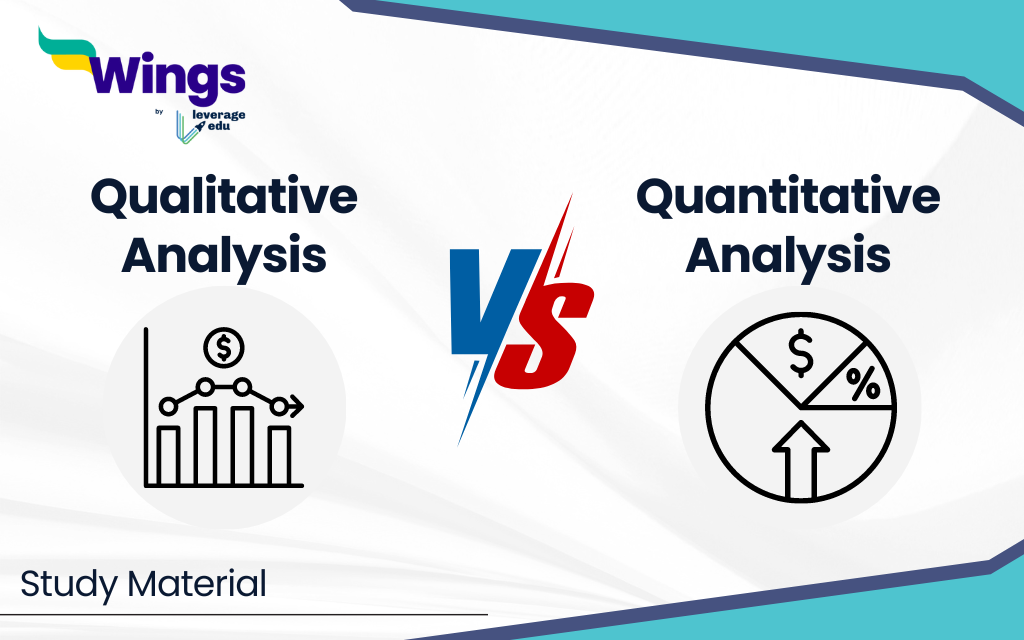The difference between Qualitative Analysis and Quantitative Analysis is that Quantitative analysis uses numbers to measure things like “how much” and “how often”. It’s all about calculations and statistics. Qualitative analysis, on the other hand, explores why things work the way they do, using descriptions and explanations, not numbers. Think of it as the ‘why’ behind the numbers.
Contents
What is Qualitative Analysis?
Qualitative analysis looks at the detailed, non-numerical parts of data. It looks into events by asking “why” and “how” using writing, pictures, or videos. Imagine breaking down the numbers into the traits, events, and views that lie behind them. This kind of information is often gathered by researchers through interviews, focus groups, and informal observations. In addition to numbers, the analysis itself includes interpretation and evaluation, giving detailed details and reasons instead.
What is Quantitative Analysis?
Quantitative Analysis is all about the numbers. It’s like a detective using math and statistics to measure and quantify aspects of a situation. It focuses on “how much,” “how many,” or “how often” something happens. Researchers often use surveys and trials to collect numbers. After collecting data, scholars use statistical methods to look for patterns, trends, and connections. Using data that can be measured, the goal is to come to objective conclusions.
What is the Difference between Qualitative Analysis and Quantitative Analysis?
When it comes to data analysis, researchers have two main tools that expert researchers use Qualitative and Quantitative Analysis. While both approaches are valuable, they differ fundamentally in how they approach data.
| Feature | Qualitative Analysis | Quantitative Analysis |
| Data Type | Descriptive (text, images, videos) | Numerical |
| Focus | Why and How | How Much, How Many, How Often |
| Methods | Interviews, Focus Groups, Observations | Surveys, Experiments |
| Analysis | Interpretations, Subjective Evaluations | Statistical Techniques |
| Outcome | Descriptions, Explanations | Numbers, Measurable Results |
Also Read: Difference Between Marginal Cost and Average Cost
Qualitative Analysis and Quantitative Analysis Formulas
Quantitative analysis doesn’t typically rely on formulas in the same way quantitative analysis does. Qualitative analysis focuses on descriptions and interpretations, so the formulas are more like general approaches.
Qualitative Analysis
There aren’t specific formulas used, but rather frameworks or methods guide the analysis.
- Thematic Analysis: Identifying and analyzing recurring themes within qualitative data.
- Grounded Theory: Developing theories based on patterns emerging from the data itself.
- Narrative Analysis: Examining stories and experiences to understand people’s perspectives.
Quantitative Analysis
This heavily utilizes formulas from statistics and mathematics to analyze numerical data.
- Mean (Average): (Sum of Values) / (Number of Values) – Used to find the central tendency of a dataset.
- Standard Deviation: Measures how far the data is from the mean.
- Linear Regression: Models the relationship between two variables using a straight-line equation.
- Hypothesis Testing: Formally evaluates if a predicted relationship between variables exists statistically.
Application of Qualitative Analysis and Quantitative Analysis in Real Life
Both Qualitative and Quantitative Analysis play vital roles in understanding the world around us. Here are some real-life applications of each.
| Qualitative Analysis | |
| Marketing | Understanding customer preferences and experiences through focus groups and interviews help companies refine products and marketing strategies. |
| Education | Understanding customer preferences and experiences through focus groups and interviews helps companies refine products and marketing strategies. |
| Social Sciences | Understanding social phenomena like poverty or prejudice requires an in-depth exploration of people’s experiences. |
| Quantitative Analysis | |
| Public Health | Epidemiologists use statistics to track the spread of diseases and identify risk factors. By analysing case data, they can determine which populations are most vulnerable and allocate resources accordingly. |
| Finance | Investment decisions rely heavily on quantitative analysis of financial data. Investors use metrics like stock price history and company earnings reports to assess risk and potential returns. |
| Sports Analytics | Teams leverage quantitative data like player performance statistics to develop winning strategies. Analyzing past game data can reveal patterns that inform player positioning and training routines. |
Also Read: Difference Between Parallel and Perpendicular
FAQ’s
Qualitative data is descriptive – it uses words, images, or videos to answer “why” and “how” questions. Imagine a review describing a restaurant’s ambience. Quantitative data is all about numbers – it helps answer “how much,” “how many,” or “how often” questions.
Qualitative analysis often uses methods like interviews, focus groups, and observations to gather data. Then, thematic analysis, grounded theory, or narrative analysis techniques are used to interpret and make sense of the data.
Quantitative analysis relies on surveys and experiments to collect numerical data. Statistical methods like calculating means, and standard deviations, or performing hypothesis testing are used to analyze the data and draw conclusions.
Quantitative analysis relies heavily on formulas from statistics and mathematics. There are no specific formulas in qualitative analysis, but rather frameworks for analyzing the data, like thematic analysis or narrative analysis.
RELATED POSTS
This was all about the “Difference between Qualitative Analysis and Quantitative Analysis”. For more such informative blogs, check out our Study Material Section, you can learn more about us by visiting our Indian exams page.
 One app for all your study abroad needs
One app for all your study abroad needs














